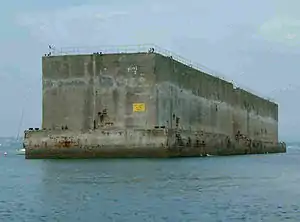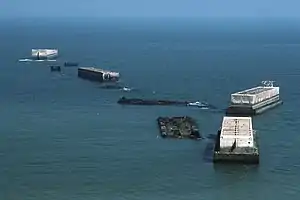Phoenix breakwaters
The Phoenix breakwaters were a set of reinforced concrete caissons built as part of the artificial Mulberry harbours that were assembled as part of the follow-up to the Normandy landings during World War II. They were constructed by civil engineering contractors around the coast of Britain. They were collected at Dungeness and Selsey, and then towed by tugboats across the English Channel and sunk to form the Mulberry harbour breakwaters replacing the initial "Gooseberry" block ships.[1] Further caisson were added in the autumn of 1944 to reinforce the existing structure to cope with the harbour continuing in use longer than planned.[1]


Several Phoenix breakwaters still exist in Britain: two are part of the harbour off Castletown at Portland Harbour and two can be dived in less than 10 metres of water off Pagham. There is also a smaller Phoenix Caisson (type C) in Langstone Harbour.[1]
A wrecked Phoenix breakwater is also to be seen, broken in two, in the Thames estuary off Shoeburyness in Essex. It broke while being towed from Harwich in June 1944. To avoid it causing a hazard to shipping in the Thames estuary, it was beached on the mud on the northern edge of the Thames dredged shipping channel. It is about a mile from the beach. It is not quite covered at high tide, but it is topped by a beacon to warn shipping of its presence.
Four Phoenix breakwaters were used in the Netherlands to plug a gap in the dyke at Ouwerkerk after the North Sea Flood of 1 February 1953. They have now been converted into a museum for the floods called the Watersnoodmuseum. One can walk through the four caissons.
See also
References
| Wikimedia Commons has media related to Phoenix breakwaters. |
- Hughes, Michael; Momber, Gary (2000). "The Mulberry Harbour Remains". In Allen, Michael J; Gardiner, Julie (eds.). Our Changing Coast: A Survey of the Intertidal Archaeology of Langstone Harbour, Hampshire. York: Council for British Archaeology. pp. 127–128. ISBN 1-902771-14-1.